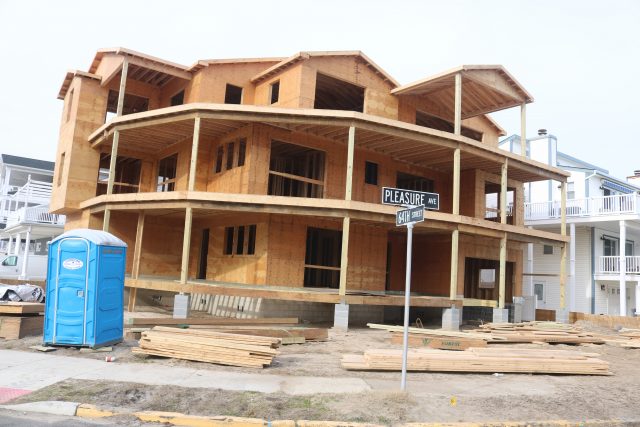By DONALD WITTKOWSKI
Using some creative thinking, Sea Isle City is revising its flood-protection requirements for the construction of new homes as part of a broader effort to regain its coveted “Class 3” status in the National Flood Insurance Program.
An amended ordinance introduced Aug. 8 by City Council will raise the minimum flood-elevation design standards for new homes by one foot.
“Last year, if you built a residence, you start at 2 feet above flood (elevation). Now, if you come in to get a permit, it will start at 3 feet above flood (elevation),” City Solicitor Paul Baldini explained of the requirements of the proposed ordinance.
However, Sea Isle is creatively changing the way that additional foot will be measured to avoid exceeding the maximum height limit – 31 feet – that new homes are allowed in town.
Currently, the base flood-elevation level is measured at the bottom of the support structure – known as the “stringers” – for a home’s floor, Baldini said in an interview Sunday.
Under the revised standards, the measurement will now be done at the top of the floor, which will effectively add a foot to a home’s base flood-elevation level without actually raising the height of the building higher than 31 feet, he said.
“As of the adoption of this ordinance, we’ll measure from the top of the floor, so that the bottom of the stringers will now be within that one foot added height. So, the end result is, the envelope remains the same, the maximum height of the building will remain the same, but the building will be one foot higher for FEMA purposes,” Baldini told the Council members at their Aug. 8 meeting.

Sea Isle has been revising and strengthening its flood-protection regulations this year in hopes of regaining its Class 3 status in the National Flood Insurance Program administered by the Federal Emergency Management Agency, or FEMA.
Once considered a Class 3 community, Sea Isle dropped down to “Class 4” following the loss of points formerly given out by FEMA for flood-mitigation measures that towns and cities implemented following Super Storm Sandy in 2012. All communities have lost the “Sandy points,” not just Sea Isle.
Under the community ranking system used by FEMA, homeowners in towns or cities designated as Class 3 are eligible for 35 percent discounts on their flood insurance. Homeowners in towns that are designated as Class 4 communities are eligible for 30 percent discounts with their flood insurance.
In June, Sea Isle adopted a comprehensive flood-control ordinance as another step to protect the low-lying island from stormwater. Baldini said FEMA is reviewing the ordinance and has indicated that Sea Isle will now have enough points to vault back into Class 3 status by this fall.
Although Council gave the flood-control ordinance its approval in June, the city will delay formally implementing it until the end of the year to give more time for discussion and fine-tuning.
The city will also delay implementing the requirement of adding an extra foot for base flood elevation in new homes until the end of the year.
“Both of these ordinances – including the FEMA ordinance – are designed to take effect at the same time,” Baldini said.
The amended ordinance introduced Aug. 8 will be up for a public hearing and final vote at the Sept. 12 City Council meeting. It will also be forwarded to the city’s planning board to make sure it is consistent with Sea Isle’s master plan.

Over the years, Sea Isle has implemented a series of major flood-mitigation projects, such as restoring the beaches and dunes, building bulkheads along the bayfront, reconstructing the roads, improving the drainage systems and erecting berms, levees and rock walls to block stormwater.
The city has also built a stormwater pumping station in the flood-prone bayfront neighborhood at 38th Street and Sounds Avenue. City officials say more pumping stations will be built to protect low-lying neighborhoods vulnerable to flooding.








